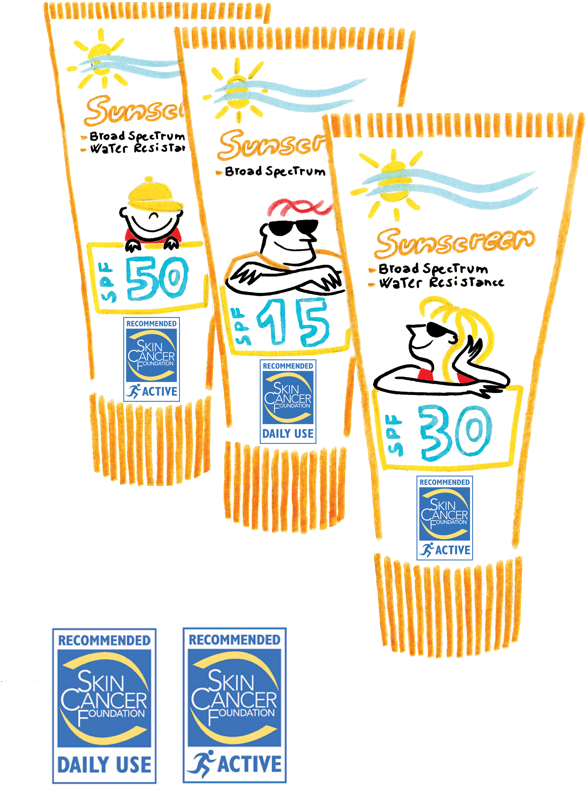Sun Protection
Your Daily Sun Protection Guide
The sun sustains life and feels good, but it can be your skin’s worst enemy. While every sunburn can increase your risk of skin cancer, it’s not just those big days at the beach or ballgame that cause trouble. Each time you run out to get the mail, walk the dog or commute to work without sun protection also adds to the damage that can lead to skin cancer (as well as leathery skin, dark spots and wrinkles).
No single method of sun defense can protect you perfectly, though. That’s why we created this roundup of advice for you. The best path to beautiful, healthy skin is to adopt as many of these steps as possible into your lifestyle, and make them daily habits everywhere you go, all year long.
Cover It Up
Clothing can provide a great barrier against the sun’s ultraviolet (UV) rays. Its protection is consistent over time and doesn’t wear off like sunscreen does. Many new fabrics offer high-tech protection and breathability, too. The more skin you cover (high neck, long sleeves, pants), the better, and a hat with a wide brim all the way around (three inches or more) is best because it helps shade your eyes, ears, face and neck. Also wear UV-blocking sunglasses to protect your eyes and the skin around them.
What does UPF mean? Look for UPF, which stands for ultraviolet protection factor, on labels for clothing, hats and fabrics. The number indicates what fraction of the sun’s UV rays can penetrate the fabric. A shirt labeled UPF 50, for example, allows just 1/50th of the UV radiation to reach your skin.
The pitfall: Any clothing leaves some skin exposed, so you need sunscreen, too. Don’t forget to apply it to your hands, especially after washing them.

Play in the Shade
When you are outside, think of shade as your refuge, especially between 10 AM and 4 PM, the peak hours of sun intensity.
Walk on the shady side of the street, sit under an awning or sun-protective umbrella, duck onto the covered porch at a pool party or even under a tree.
The pitfall: Shade isn’t a perfect shield. Some UV rays can still reach your skin. They can pass through leaves and branches, hit your skin from the side and reflect off water, sand, glass and concrete.

Know Your Sunscreen
Sunscreens come in many formulations and delivery methods, and it can take trial and error to find the one you like best. Whether it’s a sport spray, an easy-to-use stick or a rich moisturizer with antiaging ingredients, the best sunscreen is the one you will use every day.
SPF stands for sun protection factor. The number tells you how long the sun’s UVB rays would take to redden your skin when using a particular sunscreen compared with the amount of time without sunscreen. So if you use an SPF 15 product exactly as directed (applied generously and evenly, and reapplied after two hours or after sweating or swimming), it would take you 15 times longer to burn than if you weren’t wearing sunscreen.
Broad spectrum. The words “broad spectrum” on a label indicate that the sunscreen contains ingredients that effectively protect against UVA rays as well as UVB.
Water resistance. While sunscreens can’t claim to be waterproof, they can be labeled water resistant for either 40 or 80 minutes. Yes, you can burn even when you’re in the water, so reapplying is key!
Sensitive skin. Products containing zinc oxide and titanium dioxide, sometimes referred to as mineral or physical formulas, may be less likely to cause skin irritation in people who have sensitive skin.
The pitfall: Most people don’t apply sunscreen exactly as directed. They may not apply it liberally enough, might miss spots and may forget to reapply regularly. Slather it on!
The Skin Cancer Foundation advises everyone to use a broad-spectrum sunscreen with an SPF of 15 or higher every day. For extended outdoor activity, use a water-resistant, broad-spectrum sunscreen with an SPF of 30 or higher. Reapply every two hours or after swimming or sweating.

Seek the Seal: The bottom line is that you need several types of sun protection to safeguard your skin. It takes a village! Many products that meet stringent criteria for safe and effective UV protection have earned The Skin Cancer Foundation Seal of Recommendation. Look for clothing, hats, sunglasses, sunscreens, moisturizers, cosmetics, awnings, umbrellas, window film and more that carry the Seal. Search here.
Shield the Wee Ones
Infants: It’s best in the first six months to keep infants out of the sun rather than use sunscreen on their sensitive skin. Clothing should cover baby’s vulnerable arms and legs, and don’t forget to use hats, sunglasses and stroller sun shades.
Toddlers: In addition to providing a protective hat and clothing, you can apply sunscreen to children starting at six months.
The pitfall: Unexpected exposure can happen, for example, with a babysitter. Be prepared; talk to caregivers in advance about sun protection.

Look Out for Windows
While glass blocks UVB rays pretty well, it allows UVA rays to pass through. This is true of your windows at home as well as on the road.
Car windshields are treated to shield drivers from most UVA rays, but side, back and sunroof windows usually aren’t. When you’re in your car, protect yourself and your family with hats, clothing, sunglasses, sunscreen, whatever it takes. Another option is to have UV-protective window film applied to windows, in your car or at home.
The windows on airplanes, trains and buses also allow UVA rays to pass through. That’s why airline pilots, crew members and even frequent travelers may get more skin cancers than other people.
The pitfall: You need to plan ahead before traveling and make sure you have sunscreen on and protective clothing with you.

Say No to Tanning Beds
It’s simple: Don’t use a tanning bed — ever. Indoor tanning (even one time) raises the risk of all kinds of skin cancer, including melanoma. In fact, using a tanning bed before age 35 increases your risk of melanoma by 75 percent.
The pitfall: While a number of states have implemented laws prohibiting minors under a certain age (varying from 18 to 14) from using tanning beds, or requiring parental consent, other states have not restricted access. Peer pressure to be tan can affect your better judgment at any age. Say no!

Early Detection Starts with You
Using sun protection consistently from an early age is the strongest defense against developing skin cancer.
No person or method is perfect, though, and one in five Americans will develop skin cancer by the age of 70.
The Skin Cancer Foundation recommends that all adults do monthly skin self-exams and see a dermatologist annually, or more frequently if they see something suspicious or have risk factors. Learn more about early detection.

Reviewed by: Deborah S. Sarnoff, MD
Last updated: June 2021
